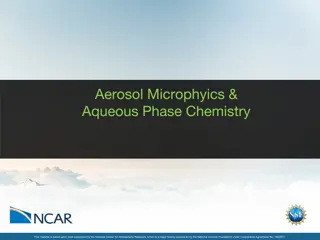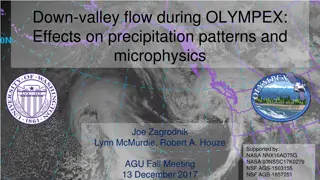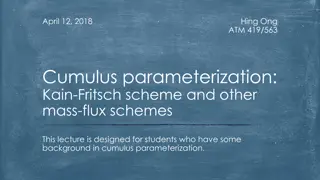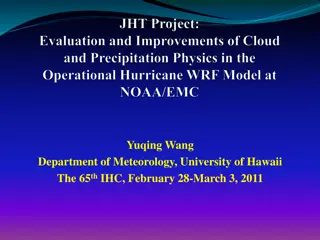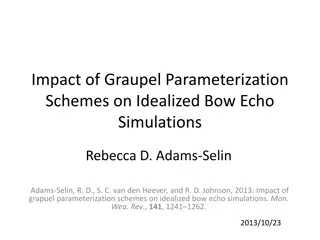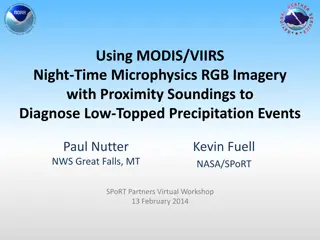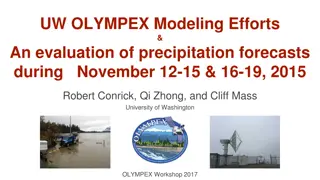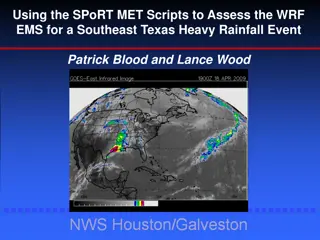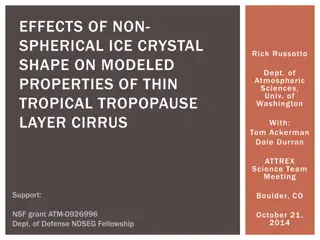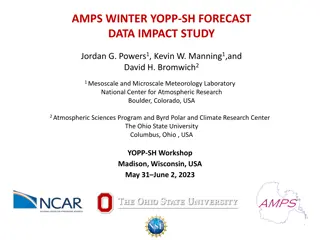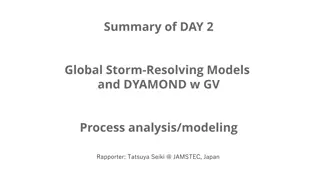Aerosol Microphysics and Aqueous Phase Chemistry in Atmospheric Research
This material delves into the study of aerosol microphysics and aqueous phase chemistry in the context of atmospheric research. It discusses topics such as scale-dependencies, obstacles in development, working groups for MUSICA, and the importance of various processes in aerosol modeling. The conten
3 views • 11 slides
Effects of Down-Valley Flow on Precipitation Patterns and Microphysics
Down-valley flow in complex terrain areas like the Alps and British Columbia modifies precipitation patterns through diabatic cooling and melting effects. Observations from the OLYMPEX field campaign show how down-valley flow is influenced by both thermodynamics and pressure gradients, with signific
3 views • 15 slides
Cumulus Parameterization and Mass-Flux Schemes in Atmospheric Science
Explore the significance of mass-flux schemes in cumulus parameterization, their interaction with grid-scale microphysics, and the key elements and assumptions involved. Learn about the objectives, components, and limitations of classical cumulus schemes for atmospheric modeling. Gain insights into
3 views • 23 slides
Evaluation and Improvement of Cloud and Precipitation Physics in Hurricane Weather Forecasting
Yuqing Wang from the Department of Meteorology at the University of Hawaii worked on evaluating and enhancing cloud and precipitation physics in the operational Hurricane Weather Research and Forecast (HWRF) model. The project aimed to improve hurricane intensity and structure predictions, focusing
3 views • 18 slides
Impact of Graupel Parameterization Schemes on Bow Echo Simulations
The study explores the impact of graupel parameterization schemes on idealized bow echo simulations, focusing on the role of the cold pool in shaping storm structure and longevity. Changes in microphysical characteristics, cold pool strength, and vorticity balance are examined using a cloud-resolvin
1 views • 23 slides
Diagnosing Low-Topped Precipitation Events Using Satellite Imagery
Utilizing MODIS/VIIRS Night-Time Microphysics RGB Imagery combined with Proximity Soundings can enhance situational awareness and aid in diagnosing low-topped precipitation events. Various satellite images and data sources are analyzed to understand why heavy rain occurred in Havre, MT, despite mini
0 views • 17 slides
Evaluation of Precipitation Forecasts Using OLYMPEX Data
This research evaluates model physics, specifically microphysics and boundary-layer schemes, using data from the OLYMPEX workshop in 2015. The study focuses on known deficiencies in microphysics schemes such as variability in location and amount for precipitation. Evaluations were conducted for case
1 views • 21 slides
GEOS-Chem Atmospheric Chemistry Model Overview
GEOS-Chem, developed by Daniel J. Jacob at Harvard University, is a global model of atmospheric composition used to understand human and natural influences on the environment. The model addresses various atmospheric chemistry issues on different scales, from local to global, and is regularly updated
3 views • 19 slides
Assessing WRF EMS for Texas Heavy Rainfall Event
Using the SPoRT MET Scripts, researchers analyzed the WRF EMS for a heavy rainfall event in Southeast Texas. The study emphasized the importance of selecting appropriate PBL and Microphysics settings for accurate assessment. Various synoptic overviews and weather data from April 18th, 2009 were used
1 views • 26 slides
Effects of Non-Spherical Ice Crystal Shape on Modeled Properties of Thin Tropical Tropopause Layer Cirrus
This study explores the impact of non-spherical ice crystal shapes on the properties of cirrus clouds in the thin tropical tropopause layer. Incorporating realistic ice crystal shapes into models affects fall speed, growth rate, and radiative absorption, influencing the time evolution of clouds. The
2 views • 38 slides
AMPS WINTER YOPP-SH FORECAST DATA IMPACT STUDY
This study focuses on the impact of enhanced sounding data and new data assimilation methods on Antarctic weather forecasts. Utilizing the Year of Polar Prediction Southern Hemisphere program, researchers aim to improve environmental prediction for the polar regions through targeted observing period
3 views • 16 slides
Air-Sea Interface Dynamics in Tropical Cyclones
Examining the influence of microphysics at the air-sea interface on the rapid intensification of tropical cyclones. Explore the impact of sea spray and theoretical models on cyclone dynamics, energy generation rates, and maximum intensity predictions.
4 views • 11 slides
Water Isotope System for Precipitation Research
Focused on measuring water vapor isotopologues in clouds, the WISPER system uses sophisticated instrumentation to study cloud microphysics and precipitation processes. Despite challenges like condensation and icing, the system provides valuable insights into cloud composition and dynamics. The limit
2 views • 32 slides
Water Isotope System for Cloud Research
Water Isotope System for Precipitation and Entrainment Research (WISPER) utilizes advanced spectrometers to measure water vapor and isotopologues in clouds. The system helps in understanding cloud microphysics, droplet formation, and vapor transfer processes. However, it faces challenges such as con
2 views • 16 slides
Enhanced Aerosol Characterisation Using CALIOP and PARASOL Observations with GRASP Algorithm
Synergy of CALIOP and PARASOL observations for enhanced aerosol characterisation utilizing the GRASP algorithm. Explore aerosol modelling, polarimeter, lidar data analysis, and forward modelling tests with detailed parameter insights. Discover total parameters available for microphysics and vertical
0 views • 16 slides
Global Storm-Resolving Models and DYAMOND with GV Process Analysis
Explore the latest advancements in storm-resolving models and process analysis with a focus on vertical motion, aerosols, convective strength, cloud microphysics, and more. Key topics include thermal plumes, convective organization, and impactful weather phenomena such as tropical cyclones and polar
15 views • 5 slides
Deutscher Wetterdienst Microphysics and Model Changes Overview
Explore the advancements in microphysics and model changes by Deutscher Wetterdienst, including cloud ice sedimentation and supercooled liquid water. Standard verification results and COSMO-EU tests are detailed. Witness the progress in meteorological forecasting at the SMC Meeting in Bologna.
1 views • 19 slides
Meteorological Research Expeditions Overview
Explore a detailed overview of multiple meteorological research expeditions conducted in various regions, focusing on severe weather phenomena like supercells, multi-cell storms, and quasi-linear convective systems. Learn about the use of cutting-edge technologies, Doppler radar analysis, microphysi
1 views • 6 slides
